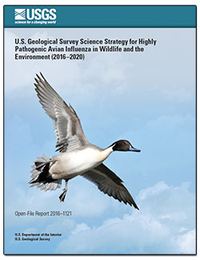U.S. Geological Survey science strategy for highly pathogenic avian influenza in wildlife and the environment (2016–2020)
Links
- Document: Report (4.77 MB pdf)
- Download citation as: RIS | Dublin Core
Introduction
Through the Science Strategy for Highly Pathogenic Avian Influenza (HPAI) in Wildlife and the Environment, the USGS will assess avian influenza (AI) dynamics in an ecological context to inform decisions made by resource managers and policymakers from the local to national level. Through collection of unbiased scientific information on the ecology of AI viruses and wildlife hosts in a changing world, the U.S. Geological Survey (USGS) will enhance the development of AI forecasting tools and ensure this information is integrated with a quality decision process for managing HPAI.
The overall goal of this USGS Science Strategy for HPAI in Wildlife and the Environment goes beyond documenting the occurrence and distribution of AI viruses in wild birds. The USGS aims to understand the epidemiological processes and environmental factors that influence HPAI distribution and describe the mechanisms of transmission between wild birds and poultry. USGS scientists developed a conceptual model describing the process linking HPAI dispersal in wild waterfowl to the outbreaks in poultry. This strategy focuses on five long-term science goals, which include:
- Science Goal 1—Augment the National HPAI Surveillance Plan;
- Science Goal 2—Determine mechanisms of HPAI disease spread in wildlife and the environment;
- Science Goal 3—Characterize HPAI viruses circulating in wildlife;
- Science Goal 4—Understand implications of avian ecology on HPAI spread; and
- Science Goal 5—Develop HPAI forecasting and decision-making tools.
These goals will help define and describe the processes outlined in the conceptual model with the ultimate goal of facilitating biosecurity and minimizing transfer of diseases across the wildlife-poultry interface. The first four science goals are focused on scientific discovery and the fifth goal is application-based. Decision analyses in the fifth goal will guide prioritization of proposed actions in the first four goals.
Suggested Citation
Harris, M.C., Pearce, J.M., Prosser, D.J., White, C.L., Miles, A.K., Sleeman, J.M., Brand, C.J., Cronin, J.P., De La Cruz, S., Densmore, C.L., Doyle, T.W., Dusek, R.J., Fleskes, J.P., Flint, P.L., Guala, G.F., Hall, J.S., Hubbard, L.E., Hunt, R.J., Ip, H.S., Katz, R.A., Laurent, K.W., Miller, M.P., Munn, M.D., Ramey, A.M., Richards, K.D., Russell, R.E., Stokdyk, J.P., Takekawa, J.Y., and Walsh, D.P., 2016, U.S. Geological Survey science strategy for highly pathogenic avian influenza in wildlife and the environment (2016–2020): U.S. Geological Survey Open-File Report 2016–1121, 38 p., https://dx.doi.org/10.3133/ofr20161121.
ISSN: 2331-1258 (online)
Table of Contents
- Executive Summary
- Vision
- Introduction
- Science Outcomes of the U.S. Geological Survey Science Strategy on HPAI in Wildlife and the Environment
- U.S. Geological Survey HPAI Science Goals
- Acknowledgments
- References Cited
- Appendix 1. Overview of U.S. Geological Survey Capabilities for Avian Influenza Research
- Appendix 2. Examples of U.S. Geological Survey Capabilities for Avian Influenza Research
| Publication type | Report |
|---|---|
| Publication Subtype | USGS Numbered Series |
| Title | U.S. Geological Survey science strategy for highly pathogenic avian influenza in wildlife and the environment (2016–2020) |
| Series title | Open-File Report |
| Series number | 2016-1121 |
| DOI | 10.3133/ofr20161121 |
| Publication Date | August 18, 2016 |
| Year Published | 2016 |
| Language | English |
| Publisher | U.S. Geological Survey |
| Publisher location | Reston, VA |
| Contributing office(s) | Alaska Science Center, National Wildlife Health Center, Office of the AD Ecosystems, Core Science Analytics, Synthesis, and Libraries |
| Description | v, 38 p. |
| Country | United States |
| Online Only (Y/N) | Y |
| Additional Online Files (Y/N) | N |


